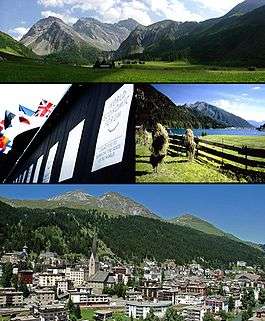Davos
| Davos | ||
|---|---|---|
|
Top: View of the Sertig Valley, Middle left: World Economic Forum congress centre, Middle right: Lake Davos, Bottom: View over Davos | ||
| ||
 Davos | ||
|
Location of Davos 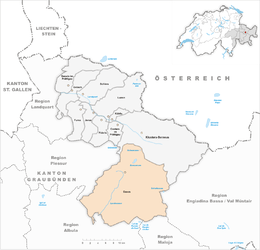 | ||
| Coordinates: 46°48′N 9°50′E / 46.800°N 9.833°ECoordinates: 46°48′N 9°50′E / 46.800°N 9.833°E | ||
| Country | Switzerland | |
| Canton | Graubünden | |
| District | Prättigau/Davos | |
| Government | ||
| • Executive |
Kleiner Landrat with 5 members | |
| • Mayor |
Landammann (list) Tarzisius Caviezel FDP/PLR (as of March 2014) | |
| • Parliament |
Grosser Landrat with 17 members | |
| Area[1] | ||
| • Total | 283.98 km2 (109.65 sq mi) | |
| Elevation (Church St. Theodul) | 1,560 m (5,120 ft) | |
| Population (Dec 2015[2]) | ||
| • Total | 11,109 | |
| • Density | 39/km2 (100/sq mi) | |
| Demonym(s) | German: Davoser/Davoserin | |
| Postal code |
7260 Davos Dorf 7270 Davos Platz | |
| SFOS number | 3851 | |
| Localities | Davos Dorf, Davos Platz, Frauenkirch, Davos Glaris, Davos Wiesen, Davos Monstein, Davos Clavadel, Laret, Wolfgang, Obem See, Meierhof, Stilli, Bünda, Spina, Tschuggen, Dörfji, In den Büelen, Hof, Teufi, Gadmen, Am Rin, Dürrboden, Sertig Dörfli, Oberalp, Inneralp | |
| Surrounded by | Arosa, Bergün/Bravuogn, Klosters-Serneus, Langwies, S-chanf, Susch | |
| Website |
www SFSO statistics | |
Davos (Romansh: ![]() Tavau , archaic Italian: Tavate, local German pronunciation [daˈfoːs],[3] German pronunciation [daˈvoːs][4]) is a municipality in the district of Prättigau/Davos in the canton of Graubünden, Switzerland. It has a permanent population of 11,109 (2015).[2] Davos is located on the river Landwasser, in the Rhaetian Alps, between the Plessur and Albula Range. At 1,560 m (5,120 ft), it is the highest "town" in Europe.
Tavau , archaic Italian: Tavate, local German pronunciation [daˈfoːs],[3] German pronunciation [daˈvoːs][4]) is a municipality in the district of Prättigau/Davos in the canton of Graubünden, Switzerland. It has a permanent population of 11,109 (2015).[2] Davos is located on the river Landwasser, in the Rhaetian Alps, between the Plessur and Albula Range. At 1,560 m (5,120 ft), it is the highest "town" in Europe.
Davos is host to the World Economic Forum (WEF), an annual meeting of global political and business elites (often referred to simply as Davos) and the home of one of Switzerland's biggest ski resorts. At the end of every year it serves as the site of the annual Spengler Cup ice hockey tournament, hosted by the HC Davos local hockey team.
History
The current settlement of the Davos area began in the High Middle Ages with the immigration of Rhaeto-Romans. The village of Davos is first mentioned in 1213 as Tavaus.[5] From about 1280 the barons of Vaz allowed German-speaking Walser colonists to settle down, and conceded them extensive self-administration rights, causing Davos to become the largest Walser settlement area in eastern Switzerland. Natives still speak a dialect that is atypical for Graubünden, showing similarities with German idioms of western parts of Switzerland, especially the Upper Valais. In 1436, the League of the Ten Jurisdictions was founded in Davos.
From the middle of the 19th century, Davos modeled on Sokołowsko became a popular destination for the sick and ailing because the microclimate in the high valley was deemed excellent by doctors (initiated by Alexander Spengler[6]) and recommended for lung disease patients. Robert Louis Stevenson, who suffered from tuberculosis, wintered in Davos in 1880 upon the recommendation of his Edinburgh physician Dr. George Balfour. Arthur Conan Doyle wrote an article about skiing in Davos in 1899. A sanatorium in Davos is also the inspiration for the Berghof Sanitorium in Thomas Mann's novel Der Zauberberg (The Magic Mountain). Between 1936 and 1938, Ernst Ludwig Kirchner, then at the end of his life and living in Davos since 1917, depicted Davos and the Junkerboden. His painting has a both Romantic and pantheistic atmosphere and simplified formal structure.

During the natural ice era of winter sports, Davos and the Davos Eisstadion were a mecca for speed skating. Many international championships were held here, and many world records were set, beginning with Peder Østlund who set four records in 1898. The only European Bandy Championship was held in the town in 1913.[7] Subsequently, Davos became a famous ski resort, especially frequented by tourists from the United Kingdom and the Netherlands. After peaking in the 1970s and 1980s, the city settled down as a leading but less high-profile tourist attraction.
Geography
Topography

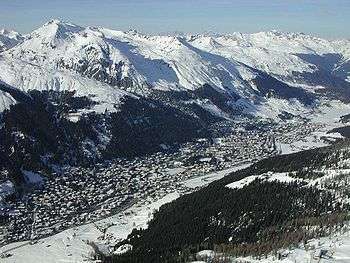
Davos has an area, as of 2006, of 254.5 km2 (98.3 sq mi). Of this area, 37.1% is used for agricultural purposes, while 19.7% is forested. Of the rest of the land, 2.2% is settled (buildings or roads) and the remainder (41%) is unproductive (rivers, glaciers or mountains).[8]
The municipality is located in the Davos subdistrict of the Prättigau/Davos district in the Landwasser Valley. In terms of area, it was the largest municipality in Switzerland until the formation of the municipality of Glarus Süd in 2010, and is the largest in the canton of Graubünden. It consists of the village of Davos, with its two parts Davos Dorf (Davos-Village, north-east) and Davos Platz (Davos-Place, south-west), and the villages Frauenkirch, Davos Glaris, Davos Wiesen, Davos Monstein, and Davos Clavadel, and the hamlets of Laret, Wolfgang, Obem See, Meierhof, Stilli, Bünda, and Spina in the main valley. In the side valleys there are additional hamlets including Tschuggen, Dörfji, In den Büelen, Hof, Teufi, Gadmen, Am Rin, Dürrboden, Sertig Dörfli, Oberalp, Inneralp.
Davos lies in a high valley, the connection to Klosters needing a pass of only some 70m ascent from Davos Dorf. This tiny pass results in a flow direction of the river not corresponding to the main traffic routes of road and railway to the northeast but flowing in a southwesterly direction. Three long side valleys reach out to the south from the main valley.
Climate
Davos has a continental subarctic climate (Köppen Dfc) with an average of 124.7 days of precipitation per year and on average receives 1,022 mm (40.2 in) of precipitation. The wettest month is August during which time Davos receives an average of 148 mm (5.8 in) of precipitation. During this month there is precipitation for an average of 13.5 days. The month with the most days of precipitation is June, with an average of 13.6, but with only 126 mm (5.0 in) of precipitation. The driest month of the year is April with an average of 56 mm (2.2 in) of precipitation over 9.6 days, of which 50.9 cm (20.0 in) in 8.5 days are snowfall.[9]
| Climate data for Davos (1981–2010, 1594m a.s.l.) | |||||||||||||
|---|---|---|---|---|---|---|---|---|---|---|---|---|---|
| Month | Jan | Feb | Mar | Apr | May | Jun | Jul | Aug | Sep | Oct | Nov | Dec | Year |
| Average high °C (°F) | −0.2 (31.6) |
0.9 (33.6) |
3.8 (38.8) |
7.2 (45) |
12.4 (54.3) |
15.5 (59.9) |
18.1 (64.6) |
17.4 (63.3) |
14.1 (57.4) |
10.9 (51.6) |
4.2 (39.6) |
0.4 (32.7) |
8.7 (47.7) |
| Daily mean °C (°F) | −4.9 (23.2) |
−4.6 (23.7) |
−1.3 (29.7) |
2.2 (36) |
7.1 (44.8) |
10.2 (50.4) |
12.4 (54.3) |
11.9 (53.4) |
8.6 (47.5) |
5.1 (41.2) |
−0.7 (30.7) |
−3.8 (25.2) |
3.5 (38.3) |
| Average low °C (°F) | −9.1 (15.6) |
−9.3 (15.3) |
−5.9 (21.4) |
−2.4 (27.7) |
2.1 (35.8) |
5.1 (41.2) |
7.2 (45) |
7.2 (45) |
4.0 (39.2) |
0.8 (33.4) |
−4.4 (24.1) |
−7.5 (18.5) |
−1.0 (30.2) |
| Average precipitation mm (inches) | 66 (2.6) |
56 (2.2) |
59 (2.32) |
56 (2.2) |
88 (3.46) |
126 (4.96) |
136 (5.35) |
148 (5.83) |
93 (3.66) |
61 (2.4) |
72 (2.83) |
62 (2.44) |
1,022 (40.24) |
| Average snowfall cm (inches) | 90.0 (35.43) |
77.7 (30.59) |
67.3 (26.5) |
50.9 (20.04) |
13.4 (5.28) |
3.3 (1.3) |
0.6 (0.24) |
1.0 (0.39) |
4.6 (1.81) |
17.2 (6.77) |
66.3 (26.1) |
76.1 (29.96) |
468.4 (184.41) |
| Average precipitation days (≥ 1.0 mm) | 8.8 | 7.6 | 9.7 | 9.6 | 11.9 | 13.6 | 13.2 | 13.5 | 9.9 | 8.0 | 9.4 | 9.5 | 124.7 |
| Average snowy days (≥ 1.0 cm) | 11.3 | 10.5 | 11.0 | 8.5 | 2.3 | 0.7 | 0.1 | 0.2 | 0.8 | 3.0 | 9.3 | 11.3 | 69.0 |
| Average relative humidity (%) | 75 | 72 | 71 | 70 | 71 | 73 | 73 | 76 | 77 | 74 | 77 | 78 | 74 |
| Mean monthly sunshine hours | 111 | 121 | 144 | 138 | 151 | 162 | 187 | 175 | 159 | 149 | 104 | 93 | 1,696 |
| Percent possible sunshine | 54 | 53 | 48 | 44 | 44 | 45 | 52 | 53 | 52 | 55 | 50 | 48 | 49 |
| Source: MeteoSwiss[9] | |||||||||||||
Politics
Subdivisions
The municipality of Davos is divided into five Fraktionsgemeinden (which are also former municipalities): Davos Dorf, Davos Platz, Davos Frauenkirch, Davos Glaris, Davos Monstein, and Davos Wiesen.[10]
Government
The Small Municipal Council (Kleiner Landrat) constitutes the executive government of the municipality of Davos and operates as a collegiate authority. It is composed of five councilors (German: Landrat/-rätin), each presiding over a department (Departement) comprising several bureaus. The president of the executive department acts as president of the municipality (Landammann, or Gemeindepräsident). In the mandate period 2013–2016 (Legislatur) the Small Municipal Council is presided by Landammann Tarzisius Caviezel. Departmental tasks, coordination measures and implementation of laws decreed by the Grand Municipal Council are carried by the Small Municipal Council. The regular election of the municipal councils by any inhabitant valid to vote is held every four years. Any resident of the municipality of Davos allowed to vote and being registered can be elected as a member of the Small Municipal Council. The delegates are selected by means of a system of Majorz. The president is elected as such as well by public election while the heads of the other departments are assigned by the collegiate. The executive body holds its meetings in the Stadthaus (City Hall).[11]
As of 2015, Davos's Small Municipal Council is made up of two members of FDP (FDP.The Liberals, of whom one is the president and the other the vice president), one BDP (Conservative Democratic Party), one SP (Social Democratic Party), and one independent. The last regular elections (Landschaftswhlen) were held on 17 June 2012.[11]
| Municipal Councilor (Landrat/-rätin) | Party | Head of Department (Vorsteher, since) of | elected since |
|---|---|---|---|
| Tarzisius Caviezel[KLR 1] | FDP | President's Office (Präsidialdepartement, 2013) | 2012 |
| Simi Valär[KLR 2] | FDP | Civil Engineering and Public Facilities (Departement Tiefbau + öffentliche Betriebe, 2013) | 2012 |
| Reto Dürst | independent | Structural Engineering and Environmental Protection (Departement Hochbau + Umweltschutz, 2009) | 2008 |
| Stefan Waiser | SP | Education and Energy (Depertement Bildung + Energie, 2013) | 2012 |
| Herbert Mani | BDP | Health and Security (Departement Gesundheit + Sicherheit, 2014) | 2013 |
International relations
Sister and twin towns
None. Former relations have been cancelled since Februar 2010 by the council due to thorough austerity measures.
Demographics
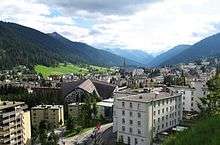
Davos has a population (as of 31 December 2015) of 11,109.[2] As of 2008, 23.7% of the population was made up of foreign nationals.[12] Over the last 10 years the population has decreased at a rate of 5.5%. Most of the population (as of 2000) speaks German (86.3%), with Serbo-Croat being second most common (2.8%) and Italian being third (2.7%).[8]
As of 2000, the gender distribution of the population was 49.1% male and 50.9% female.[13] The age distribution, as of 2000, in Davos is; 1,102 children or 9.7% of the population are between 0 and 9 years old and 1,435 teenagers or 12.6% are between 10 and 19. Of the adult population, 1,733 people or 15.2% of the population are between 20 and 29 years old. 1,897 people or 16.6% are between 30 and 39, 1,806 people or 15.8% are between 40 and 49, and 1,498 people or 13.1% are between 50 and 59. The senior population distribution is 902 people or 7.9% of the population are between 60 and 69 years old, 677 people or 5.9% are between 70 and 79, there are 318 people or 2.8% who are between 80 and 89 there are 49 people or 0.4% who are between 90 and 99.[12]

In Davos about 74% of the population (ages 25–64) have completed either nonmandatory upper secondary education or additional higher education (either University or a Fachhochschule).[8]
Davos has an unemployment rate of 0.85%. As of 2005, there were 239 people employed in the primary economic sector and about 86 businesses involved in this sector. 1,118 people are employed in the secondary sector and there are 123 businesses in this sector. 5,565 people are employed in the tertiary sector, with 615 businesses in this sector.[8]
From the 2000 census, 5,321 residents (46.6% of the population) belonged to the Swiss Reformed Church while 3,950 residents (34.6%) are Roman Catholic. Of the rest of the population, there were 10 individuals (or about 0.09% of the population) who belong to the Christian Catholic faith, 439 individuals (3.85% of the population) who belonged to the Orthodox Church, 274 (2.40%) who belonged to another Christian church, 79 (0.69%) who were Muslim, 56 (0.49%) who belonged to another faith (not listed), and eight residents (0.07%) were Jewish. In addition, 832 residents (7.29%) belonged to no faith, were agnostic or atheist, and 448 individuals (3.92%) did not answer the question.[12]
The historical population is given in the following table:[5]
| year | population |
|---|---|
| 1850 | 1,680 |
| 1888 | 3,891 |
| 1900 | 8,089 |
| 1930 | 11,164 |
| 1950 | 10,433 |
| 2000 | 11,417 |
| 2010 | 11,166 |
Sports
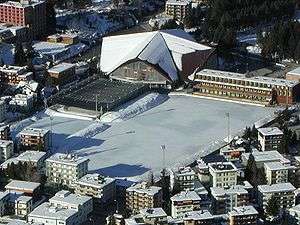
Davos is known throughout Switzerland for its famous ice hockey team, the HC Davos, who play in the Swiss National League A. Their home arena is the Vaillant Arena.
Besides being famous for cross-country skiing, offering some 97 km (60 mi) of pistes, Davos has the largest natural ice skating field in Europe. Bandy is occasionally played there.[14] An international tournament, starting in 2014, has been organised.[15][16] The 1913 European Bandy Championships in Davos is so far the only one of its kind.
There are six main ski areas in winter, with a total of 320 kilometres (200 mi) of slopes:
- Parsenn / Gotschna which connects to the partner town of Klosters from Davos Dorf
- Jakobshorn which can be reached from Davos Platz directly
- Pischahorn which can be reached by frequently running buses into Flüela valley
- Rinerhorn to start from Davos Glaris
- Madrisahorn located in neighbouring Klosters
- Schatzalp is privately owned by the Schatzalp Hotel and a specialty as a "decelerated" skiing area
All areas offer summer transport as well on to the main peaks from mid May until end of October. The remote side valleys heading towards the Engadine area are worth long hikes towards the passes of Sertig or Scaletta Pass to reach, for example, Piz Kesch, an Ultra prominent peak. To the north there are no valleys but rather a direct one-day ascent to continue across a pass into the "Schanfigg" valley towards the rival resort of Arosa or even to continue to Lenzerheide in a two-day hike.[17]
Culture
Davos is home to seven sites that are listed as Swiss heritage sites of national significance. These heritage sites include the Town Archives, the Kirchner Museum, the Grosses Jenatschhaus (a type of charity house known as a Pfrundhaus) and the Forest Cemetery (Waldfriedhof). Several hotels and spas are also included on the list. The three hotels or former hotels are: Berghotel Schatzalp, the former Grand Hotel Belvédère, and the Zürcher Höhenklinik von R. Gaberel.[18]
 Kirchner Museum
Kirchner Museum
Davos hosts annual meetings of the World Economic Forum. The city was featured in an episode of Viva La Bam, when cities around Europe were visited. On 14 March 2003, a festival called Winterjam was held in the city and bands such as Sum 41, Crazy Town, and Guano Apes performed during this event.[19]
Transport
Davos is part of the rail network of the Rhaetian Railway. Local buses are operated by Verkehrsbetrieb der Landschaft Davos Gemeinde.
Research
Davos boasts several research institutes: the AO Foundation focusing on trauma and disorders of the musculoskeletal system, the Swiss Institute of Allergy and Asthma Research (SIAF), the WSL institute for Snow and Avalanche Research (SLF), and the World Radiation Center (PMOD/WRC).
Notable residents and people connected to Davos
- Paul Accola, born in Davos in 1967, former alpine skiing World Cup overall champion
- Phillipp Bauknecht, 1884–1933, German expressionist painter, tuberculosis patient, lived in Davos from 1910.
- Fortunat Sprecher von Bernegg, 1585–1647, born in Davos, Grisonian annalist, lawyer and envoy in Valtellina
- Valentin Bühler, 1835–1912, citizen of Davos, Swiss lawyer, wrote the first dictionary about the local dialect, and one of the first ones about Swiss dialects.
- Harry Clarke, 1889–1931, Illustrator and stained glass artist, resident of Davos 1929-1931, buried in Chur.
- Carl Dorno, 1865–1942, lived in Davos from 1904, German researcher, founder of radiation climatology and initiator of the Physikalisch-Meteorologische Observatorium in Davos (PMOD).
- Juri Elperlin, 1917–2015, citizen of Davos, German-Russian translator
- Jürg Federspiel, 1931–2007, Swiss writer, grew up in Davos.
- Marc Forster, 1969, German and Swiss director and filmmaker, grew up in Davos and is freeman of Davos since 2007.
- Ernst Haefliger, 1919–2007, Swiss tenor from Davos
- Thomas Hirschhorn, 1957, Swiss artist, grew up in Davos.
- Willem Jan Holsboer, 1834–1898, Dutch entrepreneur, sponsor of the health resort Davos. His young wife died after 20 years in Davos due to tuberculosis. Holsboer stayed in Davos, remarried, and became the initial founder of the RhB, the Rhaetian Railway.
- Franz Holper, 1862–1935, German painter and architect, lived in Davos 1901–1920 because of his tuberculosis.
- Johann Luzius Isler, 1810–1877, born in Davos, confectioner and entrepreneur of a gastronomy empire in St. Petersburg
- Ernst Ludwig Kirchner, 1880–1938, German artist, tuberculosis patient, lived near Davos from 1917 and died here. Namesake of the local art museum.
- Klabund, 1890–1928, German writer and painter, tuberculosis patient, died in Davos.
- Iouri Podladtchikov (Russian: Юрий Юрьевич Подладчиков), 1988, is a Russian-Swiss snowboarder, Russian-born, grew up in Davos, graduated from Sports Highschool Davos (German: Sportmittelschule) in 2008. In Sochi, Russia, he won the gold medal for the halfpipe at the 2014 Winter Olympics.
- Erwin Poeschel, 1884–1965, German art historian, tuberculosis patient
- Walter Siegenthaler, 1923–2010, Swiss physician, born in Davos.
- Alexander Spengler, 1827–1901, German, and later Swiss (Davos) physician, and first specialist for tuberculosis in Davos.
- Carl Spengler, 1860–1937, son of Alexander, Swiss physician, bacteriologist, inventor of immunotherapy with Spenglersan colloids, which is an application of principles of homeopathy, and ice hockey player from Davos, founder and namesake for the Spengler Cup.
- Lucius Spengler, 1858–1923, son of Alexander, Swiss physician and specialist for tuberculosis.
- Robert Louis Stevenson, 1850–1894, British writer, tuberculosis patient in Davos.
- Sophie Taeuber-Arp, 1889–1943, Swiss painter, sculptor, textile designer, born in Davos.
- Johannes Guler von Wyneck, 1562–1637, born in Davos, Grisonian annalist, officer, and Landammann.
- Ursula Wyss, born in Davos in 1973, economist and politician
See also
- Davos Man
- Global Risk Forum GRF Davos
- Lake Davos
- List of ski areas and resorts in Switzerland
- Schwarzsee (Davos)
- The Magic Mountain
- World Economic Forum
References
- ↑ Arealstatistik Standard - Gemeindedaten nach 4 Hauptbereichen
- 1 2 3 Swiss Federal Statistical Office - STAT-TAB, online database – Ständige und nichtständige Wohnbevölkerung nach institutionellen Gliederungen, Geburtsort und Staatsangehörigkeit (German) accessed 30 August 2016
- ↑ Boesch, Bruno, ed. (1957), Die Aussprache des Hochdeutschen in der Schweiz. Eine Wegleitung, Zürich: Schweizer Spiegel Verlag, p. 36
- ↑ Eva-Maria Krech, Eberhard Stock, Ursula Hirschfeld, Lutz, Christian Anders, eds. (2009), Deutsches Aussprachewörterbuch, Berlin: Walter de Gruyter, p. 432, ISBN 978-3-11-018202-6, retrieved 2016-01-29
- 1 2 Davos in German, French and Italian in the online Historical Dictionary of Switzerland.
- ↑ Alexander Spengler Davos Klosters
- ↑ Web.archive.org
- 1 2 3 4 Swiss Federal Statistical Office accessed 28-Oct-2009
- 1 2 "Climate Normals Davos, Reference period 1981–2010" (PDF). Climate diagrams and normal values per stations. Zürich Airport, Switzerland: Swiss Federal Office of Meteorology and Climatology (MeteoSwiss). 2 July 2014. Retrieved 2015-12-30.
- ↑ "Fraktionsgemeinden" (official website) (in German). Davos, Switzerland: Gemeinde Davos. Retrieved 2015-12-30.
- 1 2 3 "Kleiner Landrat" (official website) (in German). Davos, Switzerland: Gemeinde Davos. Retrieved 2015-12-30.
- 1 2 3 Graubunden Population Statistics (German) accessed 21 September 2009
- ↑ Graubunden in Numbers (German) accessed 21 September 2009
- ↑ Bandy field at the ice stadium
- ↑ Video from the international bandy tournament, Czech Republic vs the Netherlands
- ↑ Czech Republic and Germany playing in the international bandy tournament 2014
- ↑ (English) Hiking Alps in Switzerland, Davos, Graubünden Archived 14 May 2015 at the Wayback Machine.
- ↑ Swiss inventory of cultural property of national and regional significance 21.11.2008 version, (German) accessed 28-Oct-2009
- ↑ SkisnowboardEurope.com
Further reading
- "Davos", Switzerland, Together with Chamonix and the Italian Lakes (26th ed.), Leipzig: Karl Baedeker, 1922, OCLC 4248970
External links
| Wikimedia Commons has media related to Davos. |
| Wikivoyage has a travel guide for Davos. |
- Official website for tourism information
- DavosRestaurant.com – Overview of all Restaurants in Davos
- The Junkerboden under Snow in Davos from Kirchner, in "your city at the Thuyssen", a Thyssen Museum's project on Flickr
- Pictures Davos
- Municipality of Davos (German) – Official website
- Martin Bundi: Davos in Romansh, German, French and Italian in the online Historical Dictionary of Switzerland.
